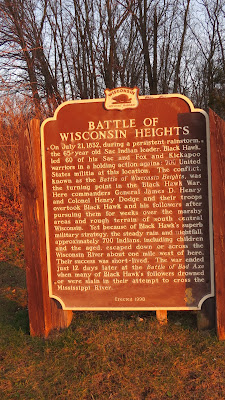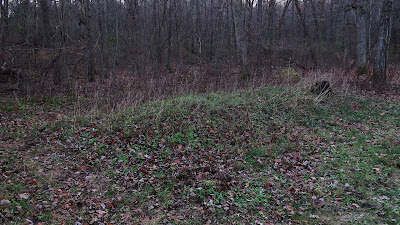My
timing and the weather finally came together so
that I made the hike through the lower part of the Blackhawk Unit of
the Lower Wisconsin Riverway. In fact I went there
twice. The
first time I stopped on my way from
work (no camera) and I
was just as pleased as I was with the upper trails. So I let it be
known that I
needed to go again soon for photos. A couple of
days later gun deer season began so that was no place I wanted to be.
A regular hiking companion took the bait after
the hunting season closed. The phone
call began that she needed to get out in nature for some exercise and
tranquility.
I had
promised to help a friend clean up some dead trees that had fallen
across the trail in her restored prairie, so that came first in the
morning. It was a windy, crisp start
to the day but the sun was bright. Along the way through the prairie
there were songbirds making short flights from seedhead to seedhead
in the tall waving Indian Grass. When we arrived at our destination
the wind of a
couple of nights
before had added another tree to block our path. Soon the chainsaw
was making manageable pieces of the now bark-less trunks. It's sad to
lose a tree,
but now before they return to the soil of “Mother Earth” we left
them in mounds to provide shelter to the prairie and woodland
creatures that
would soon make them home. This was a
great outing in nature but I wasn't done for the day.
It was
mid afternoonwhen I made the
return call about going
to Blackhawk.
“Are you still up for a hike?”
“I'll
be ready in ten minutes,”
was the reply.
Soon we were standing in front of the
historical
marker telling of a sad time
in our nation’s
past. Sadder yet,
it sounds
all too
similar to
what's still happening
around the globe to this day.
From here we
headed into where we
would be taken away from
all of today’s worries.
From here we
headed into where we would be taken away from
all of today’s worries. The paths are
wide and well-groomed.
It helped that I had been here the week before, so
I just led
the way. I should note that the signage here is very
well done. I chose
to take the trail away from the Indian Mounds;
it would eventually wind
its way back to
them. After a short time of crossing
prairie we entered a shadowy tunnel created by the tree canopy and
descended down a fallen-leaf-covered
path. Down in the valley we could hear
the gurgling of a small creek making its
way to the wetland beyond.
The clear water of the creek was bordered
on each side by
a bit of muddy goo which
someone had covered with a now slippery piece
of plywood. Our hiking skills served us well;
we both made it across without getting muddy butts
(we did
as well on the return crossing).
From here we
were again on groomed paths. The late
day sun was setting
on the rock
outcroppings,
sending rays of warm light
into dark cave-like openings.
My companion suggested perhaps someone should check to
see if there was something in them. My
return comment was,
“Go ahead.
I'll tell them that you disappeared down the rabbit hole with Alice.”
In the end,
being the older of the two of us,
my wisdom won out. We'll never know what’s down the rabbit hole.
That's what time in nature will do to you
– you become childlike
again.
The loop now took
off around the hill, up the hill and
over the dell. Before we knew it we were back at the path to the
mounds. I
was there a couple of years
ago but the mounds were hard to pick up on;
now some of the brush has
been removed and they are well defined.
I did some research about the five mounds and this is what I
got from the DNR site:
“The
property’s archaeological and historic features are rare in the
United States and represent significant past events worthy of special
note. Five linear effigy mounds located on the south boundary of the
Wisconsin Heights Battlegrounds were constructed during the Late
Woodland period between 600 and 1300 AD. Early Indians built these
earthworks, which are only found in a region bounded by southwest
Wisconsin, southeastern Minnesota, eastern Iowa and northern
Illinois. Numerous mounds along the Wisconsin River are in the form
of birds, animals and reptiles. Typically aligned with the sun at
summer solstice, linear mounds may be burial mounds or simply hut
foundations. Their real function remains a mystery and is under
study.”
The sun was
getting low in the bright blue sky but we continued on up the hill.
This part of the trail is also
used by horses so
we needed to look down more often. This side headed south toward the
other parking lot,
but from the time before I knew there was a connecting loop back.
These paths are
well-packed dirt,
winding around the hill, and covered a
more beautiful landscape with larger
rock outcroppings. No exploratory
thoughts here from my companion. In a more damp part of the woods we
both got caught up in the amazing lichens, brackens
and colorful things that were growing on
the rotting tree trunks. We didn't see any horses this day but we
were greeted by a couple of
dogs that were
having as much fun as we were as they dragged their owners along the
path. The now very low sun in the sky cast its
radiant light on some of nature’s
most brilliantly colored but simple forms.
To think all this
beauty is just a short distance from our back doors and
if we look
it's probably also right out our back doors!
.














all great photo's!! ONE of these days i'll make it up there.
ReplyDeleteGreat pictures! Kind of wish I'd gone along now....
ReplyDelete